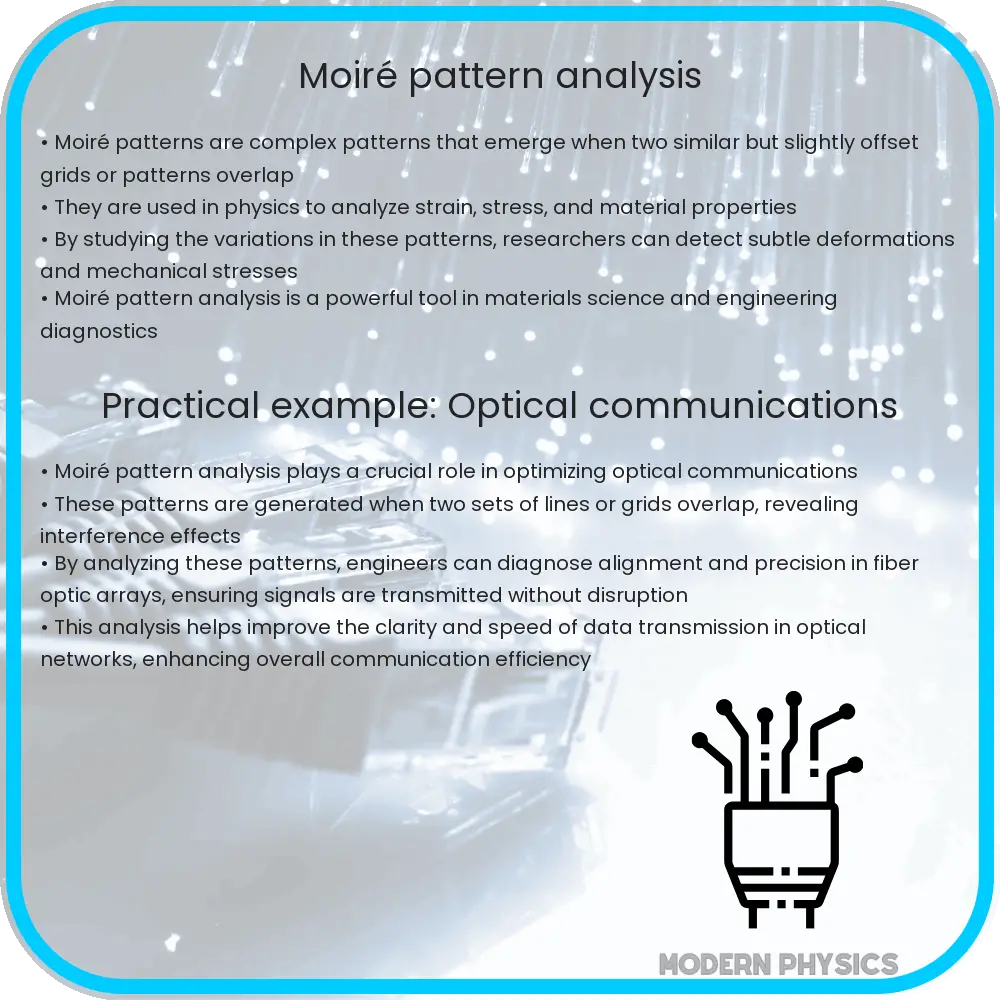Explore moiré pattern analysis techniques, their precision, and optical applications. Unlock insights into material strain, surface topography, and more.

Moiré Pattern Analysis: Unlocking Precision and Techniques
Moiré patterns, a phenomenon manifesting as large, visible patterns that emerge when two fine patterns overlap, have fascinated scientists, engineers, and artists alike. These patterns, while aesthetically pleasing, hold significant importance in the realms of precision measurements, material science, and optical engineering. Through advanced analysis techniques, moiré patterns offer insights into surface topography, strain distribution in materials, and even the alignment of layered structures in electronics.
Understanding Moiré Patterns
At the core of moiré pattern formation is the interference generated when two repetitive patterns are superimposed. This could be as simple as overlaying two sets of parallel lines or grids that are slightly misaligned or have slightly different spacings. The resulting pattern’s geometry and dimensions can reveal precise information about the alignment, displacement, and deformation of the underlying structures.
Techniques for Moiré Pattern Analysis
- Photographic Method: One of the simplest yet effective techniques involves capturing the moiré pattern using high-resolution photography. This method is particularly useful in analyzing strain distribution across a material under stress.
- Projection Moiré: This technique projects a grid pattern onto an object’s surface. The reflected image, when overlaid with another grid, forms moiré patterns that can be analyzed to measure surface topography.
- Grating Interferometry: Used primarily in the microelectronics industry, grating interferometry involves the superimposition of gratings at different angles or periods. The resulting moiré patterns can achieve nanometer precision in measuring displacements and deformations.
Optics and Moiré Patterns
The role of optics in moiré pattern analysis cannot be overstated. High-quality optical systems are essential for generating and capturing clear, precise patterns. Advanced lenses and digital imaging sensors are employed to enhance the visibility and detail of moiré patterns, enabling accurate measurements. Furthermore, the use of coherent light sources, such as lasers, has improved the precision of moiré pattern analysis, allowing for the detection of sub-micrometer displacements.
The intersection of moiré pattern analysis with digital image processing has opened new avenues for automated, high-precision measurements. Software algorithms can now extract quantitative information from moiré patterns with unprecedented accuracy, facilitating their application in various scientific and engineering disciplines.
Advanced Applications of Moiré Pattern Analysis
Moiré pattern analysis extends beyond the laboratory, finding applications in industries ranging from aerospace to semiconductor manufacturing. In aerospace engineering, moiré patterns are utilized to detect and measure stress concentrations and material defects that could lead to structural failures. Similarly, in the semiconductor industry, moiré pattern analysis plays a crucial role in the alignment of photomasks and wafers, ensuring the precise fabrication of microelectronic components.
Furthermore, the technique has also made significant inroads into the field of nanotechnology and materials science. For instance, researchers employ moiré patterns to study the properties of graphene and other two-dimensional materials. By analyzing the patterns formed by the overlay of different graphene layers, scientists can infer the material’s electronic properties, such as conductivity and band structure.
Challenges and Future Directions
Despite its wide-ranging applications, moiré pattern analysis is not without its challenges. One of the primary difficulties lies in the interpretation of complex patterns, which require sophisticated software and a deep understanding of the underlying physics. Additionally, the accuracy of moiré pattern analysis is heavily dependent on the quality of the optical setup and the precision of the alignment between the patterns.
Looking forward, the future of moiré pattern analysis appears promising, with ongoing advancements in optics, digital imaging, and computational algorithms. Researchers are continuously developing methods to enhance the sensitivity and resolution of moiré pattern analysis, aiming to unlock even deeper insights into the micro- and nano-scale world. The integration of artificial intelligence and machine learning offers the potential to automate and refine the analysis process, opening new possibilities for real-time monitoring and control in manufacturing and material science.
Conclusion
Moiré pattern analysis stands as a testament to the beautiful complexity that arises from simple principles of interference and superposition. Through the meticulous study of these patterns, scientists and engineers can glean detailed information about material properties, structural integrity, and nanoscale phenomena. As technology progresses, the precision, applications, and techniques of moiré pattern analysis will continue to expand, further cementing its role as a pivotal tool in scientific and industrial advancement. The convergence of optical engineering, digital technology, and computational analysis heralds a new era of precision and possibility, promising to unveil the unseen intricacies of the world around us.
Is this conversation helpful so far?
